Snapdragon 800 (MSM8974) Performance Preview: Qualcomm Mobile Development Tablet Tested
by Brian Klug on June 18, 2013 8:00 PM EST3DMark
3DMark for Android features the Ice Storm benchmark and uses OpenGL ES 2.0. Ice Storm is divided into two graphics tests and a physics test. The first graphics test is geometry heavy while the second test is more pixel shader intensive. The physics test, as you might guess, is CPU bound and multithreaded. The overall score takes into account both graphics and physics tests. The benchmark is rendered to an offscreen buffer at 720p/1080p and then scaled up to the native resolution of the device being tested. This is a very similar approach we've seen by game developers to avoid rendering at native resolution on some of the ultra high resolution tablets. The beauty of 3DMark's approach here is the fact that all results are comparable, regardless of a device's native resolution. The downside is we don't get a good idea of how some of the ultra high resolution tablets would behave with these workloads running at their native (> 1080p) resolutions.
For these benchmarks we stuck with the default presets (720p, normal quality).
Here the key comparisons are against the Adreno 320 based HTC One/SGS4 (T-Mobile) and the PowerVR SGX 544MP3 based SGS4 (SHEVE300S). The Nexus 10 is interesting but pretty much a blowout. Snapdragon 800 is clearly the new high-end Android tablet SoC of choice.
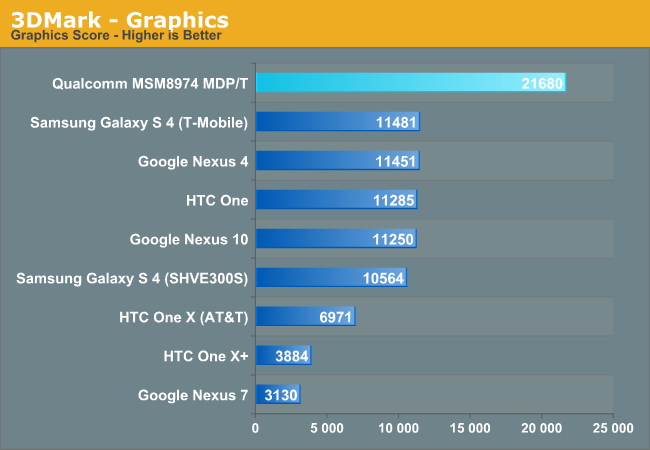
The overall graphics score from Adreno is amazing. We're looking at almost 2x the next fastest contender here, the Adreno 320 based Snapdragon 600.
Graphics Test 1
Ice Storm Graphics test 1 stresses the hardware’s ability to process lots of vertices while keeping the pixel load relatively light. Hardware on this level may have dedicated capacity for separate vertex and pixel processing. Stressing both capacities individually reveals the hardware’s limitations in both aspects.
In an average frame, 530,000 vertices are processed leading to 180,000 triangles rasterized either to the shadow map or to the screen. At the same time, 4.7 million pixels are processed per frame.
Pixel load is kept low by excluding expensive post processing steps, and by not rendering particle effects.

Graphics Test 2
Graphics test 2 stresses the hardware’s ability to process lots of pixels. It tests the ability to read textures, do per pixel computations and write to render targets.
On average, 12.6 million pixels are processed per frame. The additional pixel processing compared to Graphics test 1 comes from including particles and post processing effects such as bloom, streaks and motion blur.
In each frame, an average 75,000 vertices are processed. This number is considerably lower than in Graphics test 1 because shadows are not drawn and the processed geometry has a lower number of polygons.
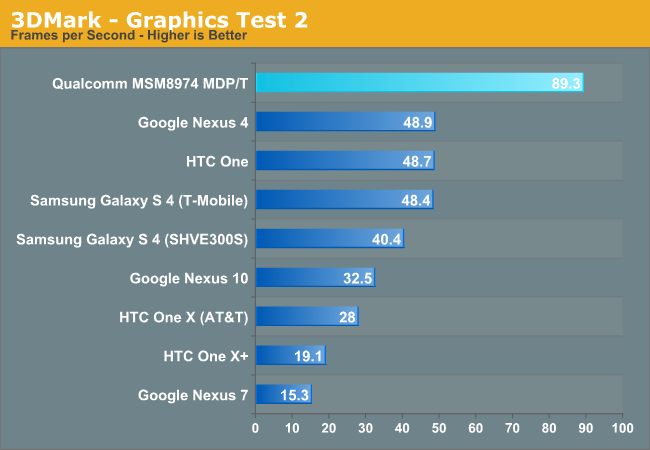
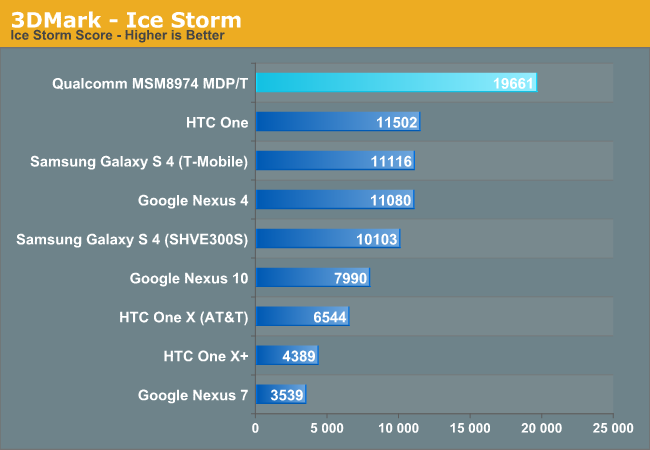
The overall Ice Storm score shows a 71% improvement over Snapdragon 600, which is the closest competitor.
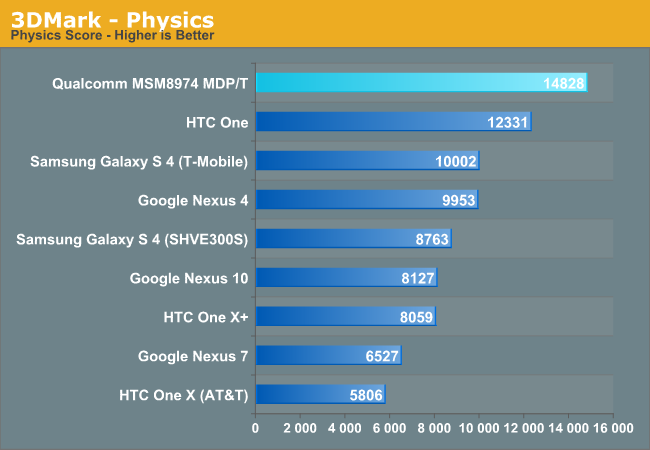
The physics test takes multicore CPU performance into account, but even then the Snapdragon 800 remains ahead of the pack. The performance advantage over the lower clocked Snapdragon 600 shrinks to just 20%, which is a bit lower than clock speeds alone would normally tell us.
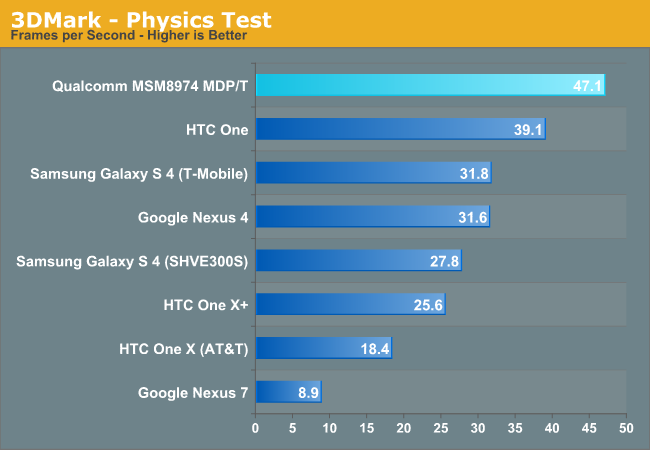










115 Comments
View All Comments
xaml - Wednesday, June 19, 2013 - link
Thanks for sneakily including a comparison of the two Galaxy S4s as well.etre - Wednesday, June 19, 2013 - link
It seems to me that everything is depending on the power budget, as the dual core A15 inside Nexus 10 is faster in some tests then the quad A15 in S4. Or I am wrong ?mczak - Wednesday, June 19, 2013 - link
Yes in some tests (like 3dmark physics) it is very obvious the quad A15 aren't running anywhere close to their max frequency. This is not surprising last time I looked at some power draw figures just two A15 cores at max frequency alone (so without graphics) could already exceed the power budget of the whole chip.So we'll see how that new Snapdragon chip compares once it's inside a smartphone. Should still be plenty fast but some scores might suffer (maybe we're going again to see freezer vs. no freezer results :-)).
sherlockwing - Wednesday, June 19, 2013 - link
The answer is simple, Dual Core A15s are running on Tablet TDP limits(4W) while the Quad core A15 in Exynos Octa are running on Phone TDP limits(<2W).HisDivineOrder - Wednesday, June 19, 2013 - link
These SOC GPU's are rapidly catching up to PC GPU's. They aren't there yet, but they've made impressive strides in just a few short years.Consoles better start more rapid update cycles or they are going to be left behind at this rate.
sireangelus - Wednesday, June 19, 2013 - link
I just wanted to make people realize something:Assassin's creed 1 & 2 run very well on an old x1950pro, and this chip seems to me that it's faster. When they said that soon mobile platform would exceed the(actual but) old consolle generation they weren't kidding.douglord - Wednesday, June 19, 2013 - link
This looks great - but frankly I need to see this vs Tegra 4 and A7. Also - I agree we need to see vs HD5000/HD5200 Haswell.Tegra 4 is probably a toss up performance wise - and will come down to power (which Qualcom normally wins). Kinda makes me sorry I pre-ordered a Shield when this will be in the Note 3 and I could just attach a controller. Hopefully Nvidia can do a better job of getting AAA games to actually support Shield. I'm sick of all the blockbusters being iOS only (or 6 months early).
Apple seems to double performance every year, and with PowerVR 6 - you could get a bigger bump. That would easily surpass this. If AAPL would just come out with a larger screen, I'd go back to iOS this time around.
And IF we see Haswell tablets with 7-9 hours of battery life - I'm not sure all of this stuff doesn't get relegated to the dust bin of history with Intel taking 90%+ of the tablet/hybrid market.
Anyone have any info on Saltwell's GPU? I love my Latitude 10's ability to run full Windows programs - particularly Office. The CPU beats anything in this article and the power use is low enough I get 16 hours of battery life. But the GPU is so far behind all of these other chips even a 2x-3x improvement isn't going to make it competitive. Why can't they throw in whatever Apple is going to use in the A7. They own part of PowerVR too!
aicom - Wednesday, June 19, 2013 - link
I'll be interested to see how the actively-cooled Tegra 4 in Shield performs compared to the standard passively-cooled stuff. I'd suspect that if you're going to be gaming for a while, the Shield may pull away. Tablets and smartphones these days aren't designed to run at full tilt all the time.The most interesting thing about this generation of SoCs to me is the CPU performance. I don't game all that often, so I'd much prefer a device that has CPU performance to spare. It's the opposite of the problem that we had on the desktop years ago. Now we have GPU performance sufficient for UI acceleration, media decoding, and mainstream gaming, but we still have CPU performance that holds the platform back.
krumme - Wednesday, June 19, 2013 - link
No your Atom does not beat anything worthwhile in this world and especially not the s800:http://browser.primatelabs.com/geekbench2/compare/...
"Intel taking 90% of the tablet/hybrid market"
Ahemm. And how exactly are they going to do that. With a usd 150 APU sans LTE/3G integrated?
Speedfriend - Thursday, June 20, 2013 - link
No with a processor offering 4x the performance of anything that ARM offers. Believe it or not, most corporate users want something that can run enterprise level apps, not some jewel swapping game.